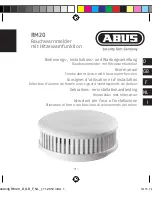
WARNING! BATTERY DOOR WILL NOT CLOSE UNLESS BAT-
TERY IS PRESENT. REMOVAL OF BATTERY WILL RENDER THE
SMOKE ALARM INOPERATIVE.
IMPORTANT! READ ALL INSTRUCTIONS BEFORE INSTALLA-
TION AND KEEP THIS MANUAL NEAR THE ALARM FOR
FUTURE REFERENCE.
CONTENTS OF THIS MANUAL
1 -- RECOMMENDED LOCATIONS FOR SMOKE ALARMS
2 -- LOCATIONS TO AVOID
3 -- INSTALLATION INSTRUCTIONS
4 -- OPERATION AND TESTING
5 -- NUISANCE ALARMS
6 -- MAINTENANCE
7 -- LIMITATIONS OF SMOKE ALARMS
8 -- GOOD SAFETY HABITS
9 -- NFPA PROTECTION STANDARD 72
10 -- CALIFORNIA STATE FIRE MARSHAL REQUIRED INFORMATION
11 -- SERVICE AND WARRANTY
1. RECOMMENDED LOCATIONS FOR ALARMS
• Locate the first alarm in the immediate area of the bedrooms.
Try to monitor the exit path as the bedrooms are usually farthest
from the exit. If more than one sleeping area exists, locate addi-
tional alarms in each sleeping area.
• Locate additional alarms to monitor any stairway as stairways act
like chimneys for smoke and heat.
• Locate at least one alarm on every floor level.
• Locate an alarm in every bedroom.
• Locate an alarm in every room where electrical appliances are
operated (i.e. portable heaters or humidifiers).
• Locate an alarm in every room where someone sleeps with the
door closed. The closed door may prevent an alarm not located
in that room from waking the sleeper.
• Smoke, heat, and combustion products rise to the ceiling and
spread horizontally. Mounting the smoke alarm on the ceiling in
the center of the room places it closest to all points in the room.































